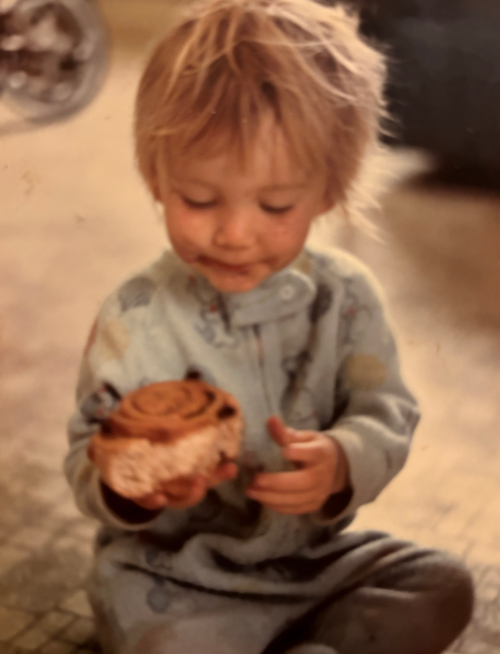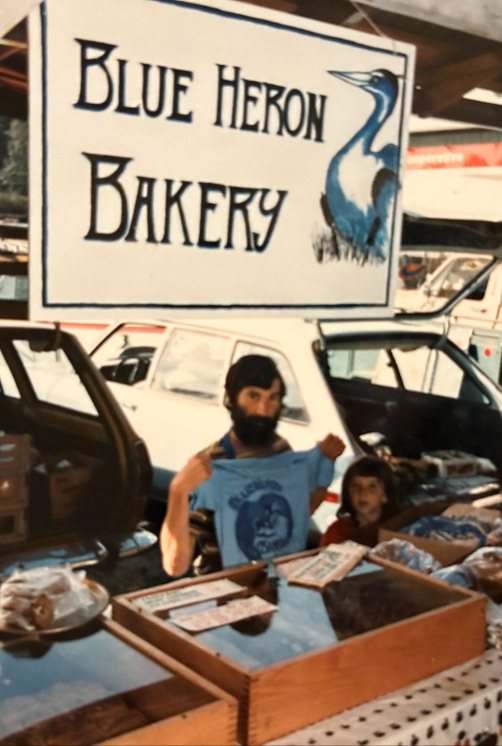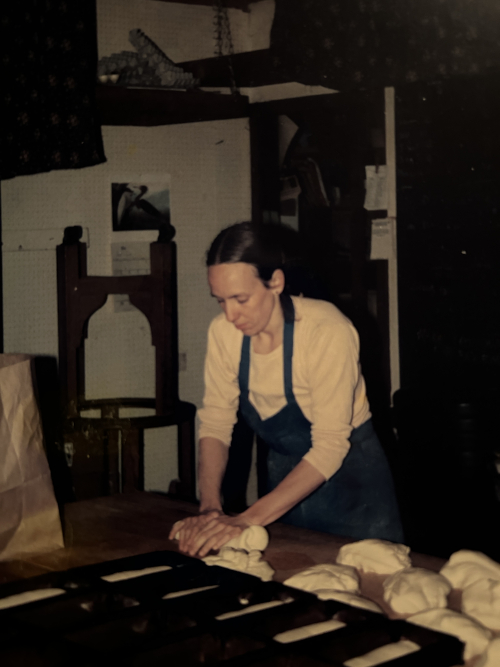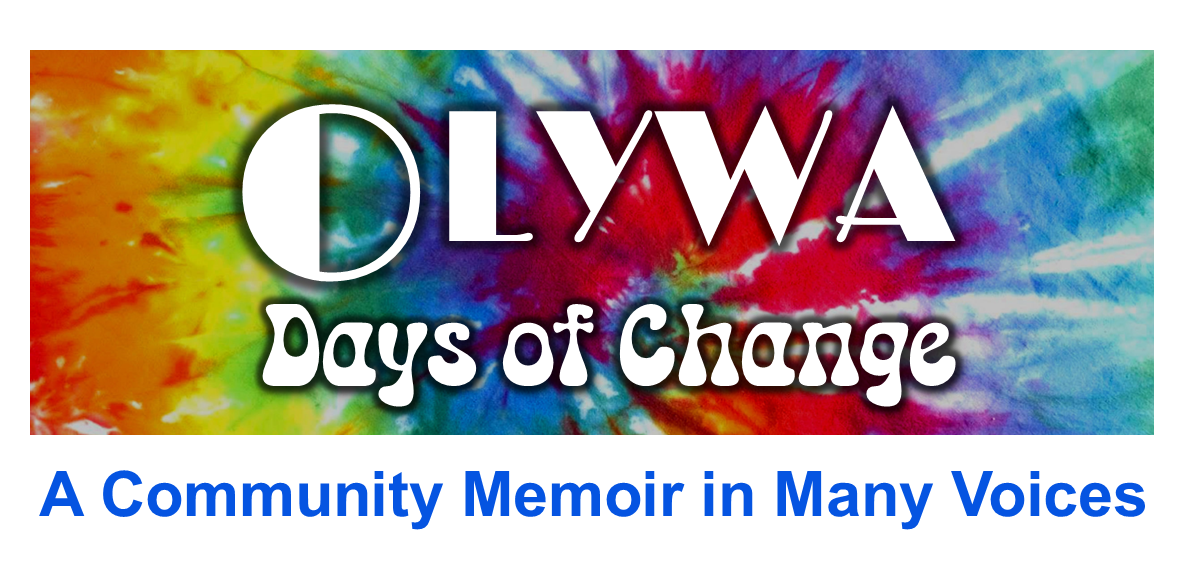WORK
Blue Heron Bakery – 1978 – 1987
By Margie Schubert

I moved to Olympia in the fall of 1972 to attend Evergreen. My last year as a student, it was in a program called “A Year in Nepal,” living in Nepal from June 1975 until June 1976. We did home stays and studied Nepali for the first two months and then got turned loose to do independent projects. I created a photo essay about Sherpa children, focusing on the young monks (ages five to 15) from Solu Khumbu who were living in a monastery outside of Kathmandu which was run by a group of monks and lamas from Tibet. I landed back in Olympia for the summer to develop photographs and write my essay. Then I was officially done with college.
That fall, when Harry and I discovered we were pregnant, we got married and moved to Stanley, Idaho—population 67—where Harry had built a log summer cabin for his parents on a hill overlooking Crooked Creek meadow and the Sawtooth Mountains. That spring, Carmela came to visit us with baby Yonkela at her breast. She was a great support to me, as I knew nothing about pregnancy, childbirth, or caring for an infant. She aspired to become a midwife and modeled caring for Yonkela with ease and grace. She also told us about a project that she and her husband, Greg, were involved in, starting a whole grain collective bakery in Olympia. We spent the summer in a tipi by the creek and in late August gave birth in the cabin, 60 miles over a mountain pass from the nearest hospital. We stayed throughout the winter. Temperatures occasionally got down to 60 below at night. After living through the isolation of a snowed-in winter as a new couple and parents, we headed back to Olympia to find our tribe.

Blue Heron Bakery was founded in 1977 by Greg, Carmela, Doug, Martha, and Terry. Harry and I moved to Olympia with our one-year-old daughter, Delphine, to cover for Terry for a month. It turned into 10 years. We rented a grounded houseboat across the street from the bakery and shared one position, deciding daily who was working at the Bakery and who was staying home with Delphine. We could even trade places at any time during a shift. Our second daughter, Maile, was born two years later, and I stayed home for six months before returning to job sharing across the street.
A year later, with the help of Harry’s parents, we bought a house out towards Evergreen and began bike commuting to Mud Bay. In 1986, I went back to Nepal for a month and came home with hepatitis. I was unable to work for a few months, and then I became pregnant with our son Avery. Harry took a job with Sea Blossom Seafoods at the Farmers Market, and I continued to work part time at Blue Heron up until Avery’s birth. Ten-year-old Delphine worked with me selling at the Farmers Market and knew all of the prices and products. She was totally adept at making change and the money went into a cigar box.

Early wholesale customers of Blue Heron were the Olympia Food Coop, the Herb and Onion Restaurant, and the Gnu Deli. Baked goods were sold at the Farmers Market from its inception, and retail from the front of the bakery in Mud Bay while we worked. We baked fresh cinnamon rolls and croissants every morning and we made seven or more kinds of bread and bagels three days a week, including whole wheat, seed, cinnamon raisin, herb and onion, all rye, caraway rye, three seed, black bread and sourdough white. Other days we baked “Ultimate” oatmeal cookies (raisin walnut and date cashew), sesame bars, carob brownies, coconut dream bars, and special order cheese cakes and carrot cakes. Our sweets were made with honey which was delivered in 50-gallon drums. Our bread was mostly whole wheat and organic and the flour was delivered weekly from Fairhaven Mill in Burlington. Sometime in the mid-1980s we got a big wholesale account for granola. That became a whole new thing, with bakers working throughout the night once or twice a week to make enough granola to fill the orders coming in.
For a long time, our weekly meetings were often hijacked by big feelings and lack of structure. None of us knew how to run a productive meeting. When Melissa joined us, she taught us a few things, and then Grace Cox helped us draft a mission statement. The meetings got better, but in other ways things got more challenging as the collective grew. At least four different members were involved in extra-marital affairs, some brief and a couple that lasted for years. Instead of cooperation, there were often power struggles involving attitudes like, “Don’t tell me what to do,” and “If you’re for it, I’m against it.” Towards the end of my time there, money was disappearing from the till and everyone knew it, but no one knew how to hold anyone accountable. It was messy, and yet the supplies were received, the bread got baked and delivered, the bills were paid, and we had a lot of fun.

In the early years, we didn’t have an electric mixer. We mixed everything by hand or with large wooden spoons or whisks in giant mixing bowls, balanced on top of open barrels. We made up to forty loaves at a time, starting with a sponge of warm water, honey, yeast and half of the flour. After it rose for a while, we added salt, oil, more flour and the other ingredients. Then we kneaded the dough by hand (a full body workout), let it rise again, punched it down, cut it into one and a half pound blobs on the big butcher block table, shaped the loaves and put them in pans to rise one last time. When they were ready, we baked them in our old, erratic second hand ovens for about an hour, rotating the pans halfway through. We discovered things like if you forget to add the salt there will be a hole in the middle of the loaf when it’s done. When we finally bought our first mixer, a very old Hobart, we stood there laughing with delight as it effortlessly mixed and kneaded the dough. The old mixer was soon replaced with a new Hobart, paid for in monthly installments. Money was always tight. Harry and I were paid about $6.00 per hour for most of the time we worked there, supplemented by food stamps.
The bakery was an important part of my life and our young family. Greg and Carmela’s kids grew up with ours for most of those years. We attended each other’s births and shared childcare. My brother Johnny and his wife Pam lived and worked with us one summer before heading off to Fiji to serve in the Peace Corps. Greg, Carmela, Yonkela, and Dicken surprised us and showed up in Idaho for Johnny and Pam’s wedding at the end of the summer.
On those 90 degree summer days with the ovens going it got really hot in the bakery. I often stuck my head under the faucet in the big sink in the back. Barb Dragul and I loved to finish our shifts by eating a baked potato with broccoli and eggs and then going off to swim across Ward Lake and back. When my sister’s life fell apart, she came to live with us. She recovered slowly over a period of months by first sitting in a chair at the bakery watching, then picking up a broom and sweeping the floor, then helping to squash the big oatmeal cookies, and eventually shaping loaves, slicing, and bagging bread.
In 1982, I left two-year-old Maile with my parents in Maryland and took Delphine with me to the annual whole grain collective bakery conference in upstate New York. It was so fun and interesting to hang out for most of a week with all of these people that I had so much in common with! Among many other things, we talked about the challenges of being in a collective, swapped recipes, and went on a field trip to the Moosewood Restaurant. There was full-time childcare, and since Delphine was the only child attending, she had one-on-one attention the whole time and did lots of fun art projects. It was a real vacation from parenting for me. A couple of years later Blue Heron hosted the annual conference in Olympia. Everyone camped out in Greg and Carmela’s back yard.
Around the time I stopped working at Blue Heron, all of the original members were moving on. I don’t remember who all stayed, or signed on at that time. The bakery was in debt for back taxes, and Jim decided to take charge and change the bakery from a collective to a sole proprietorship.
Looking back, what I liked most about being part of Blue Heron was how it was our creation. I knew every part of the business and had an influence on which directions we moved in. I was young and inexperienced, and I learned and grew in so many ways. I’ve always been a kinesthetic learner, learning by trial and error. I was a good collaborator but I suppose I was also one of those people that didn’t want anyone telling me what to do!
After staying home with Avery for a year, I went to work for Diane Wiatr at Thousand Cranes Futons for the next 10 years. It was a relief to make and sell products that didn’t mold after a week, and to collaborate with just one other like-minded person. When my daughters were in high school, they worked in the store with me sometimes after school. After we closed Thousand Cranes, I worked at the Dispute Resolution Center for 10 years. I loved being part of the staff team led by Evan Ferber. It was meaningful and growthful to learn and teach healthy communication and conflict skills, but most fun of all was working with a team, completely trusted to be in charge of my own work. We brought our challenges to staff meetings for collaboration and we laughed a lot!
I’ve been retired for eight years now, and I live at Woodard Lane Cohousing with my second husband of 24 years. Cohousing is a rich experiment in self governance and shared responsibilities. When I look back at my adult life, I see that I have always been learning about community, communication, and how to share power in service of a healthier world. Blue Heron was a good place to start!
We encourage readers to use the form below to make comments and suggestions. Disclaimer
